By: Len 'Viking1' Hjalmarson
Date: 1999-12-15
An interview with Kevin Bezant of Razorworks, with assistance from Dave Lomas (AI) and Todd Gibbs (flight models). Please note that the terrain and buildings are still work-in-progress.
Some time back Razorworks released Apache-Havoc, simulating the AH-64 Apache/Mi- 28 Havoc combination. These two choppers represent the best of the operational helicopter technologies of the American and former Soviet-bloc countries. At the time of release we were informed that an interoperable simulation of the Comanche-Hokum duo would follow. As we near that date more information has become available, and the Razorworks crew consented to this interview.
Q. Thanks for taking the time! Can you introduce yourselves and tell us a bit about your background as it relates to PC simulations?
A: We're Razorworks, based in Oxford, England. We are currently developing Comanche Hokum as a successor to Apache Havoc. Previously some of us worked for Digital Integration on titles such as Tornado, Apache Longbow and Hind.
Q. C-H includes not only new gunships but also new theatres. What are the primary differences between the Comanche/Apache and the Havoc/Hokum? What difference does this imply for tactics?
A: The main feature of the Comanche is the stealth technology. I've read that in a full stealth configuration (gun stowed, gear raised, bay doors closed and no stub wings attached) that the radar signature of the Comanche is 1/600th of that of a single Hellfire missile!
Tactically, this means that the Comanche should excel at Scout and Recon missions. The Comanche has been designed to be 'mission agile' and can be configured for attack/precision strike missions. The Comanche has all glass cockpits (the pilot and co-pilot cockpits are identical - the pilot sits in the forward seat).

The Hokum is a very different beast to the Havoc, the most obvious features being the co-axial main rotor configuration and the side-by-side crew seating arrangement. The Hokum's cockpit is more modern than the Havoc's having more multi-functional displays and a few standby instruments.
There is a lot of rivalry between the manufacturers. Kamov claim that the Hokum is more manoeuvrable than the Havoc and the side-by-side seating arrangement helps with communication whilst Mil claim that the co-axial rotor arrangement of the Hokum is disastrous for combat helicopters (the blades can clash in high-g manoeuvres) and that the seating arrangement restricts the pilot's view.
They also say that the ejector seat system in the Hokum is of little practical use because the discarded rotors are likely to damage other gunships in the formation. Tactically, the Hokum probably wins on an ease of use basis but I'd agree with Mil and say the pilot's view is more restrictive.

Q. The virtual cockpits are looking very, very good! Will there also be fixed cockpit views or have you gone exclusively 3d?
A: The cockpits are exclusively 3D and therefore work at all permissible screen resolutions (those between 640x480 and 1600x1200 which have a square aspect ratio).

Q. The animated crew looks to add a great deal to the immersion factor. Are these guys actually doing something or are they only there for show? That is, do they hit an appropriate button when I do?
A: The animated crew do re-act to some stimuli such as the pilot's arms and legs move with the controls but they also 'freelance' a bit on the button pushing. If they reacted to the actual keypress then the delay would have been intolerable.
There are some nice touches. The Hokum crew will lower their night vision goggles when they are in use and the Comanche crew's HIDSS (Helmet Integrated Display Sighting System) is actually projected on to the lenses. Initially we decided to include the crew because of the side-by-side seating in the Hokum, it would have looked very odd if they weren't there. Once the crew were in place we decided to bring them to life.
Q. Tell us about the new campaign theatres.
A: "Sword In The Sand" involves a bit of sabre rattling over a border dispute between Yemen and Saudi Arabia, "Task Force Lebanon" involves the US sending a task force into Lebanon and "War Of Independence" involves the Chinese invading their 'rebel' state.
Q. When I spoke to you at E3 you mentioned the amount of work that was going into rebuilding the AI. Tell us about the difference this makes in wingman performance.
A: A large percentage of the AI has been completely re-written for C-H making it a very different game to Apache-Havoc. During normal flight, wingmen will fly in formation with the flight leader and not just go racing off on their own as they did in A-H. This means that if you are the flight leader, your wingmen will follow you around and stay in formation with you. You will also be able to change formation during flight via the radio comms system. If you are not the flight leader however, then you will be expected to keep up with the rest of the group (but they may periodically wait for you if you lag behind).
The most significant improvement in the AI for Comanche-Hokum is in the combat department. Your flight group will search their surroundings for places to hide, and bob-up and fire on your command. Buildings, bridges, forests and hills are some of the things that helicopters will use to mask themselves.
Q. Tell us about the comms structure. What kinds of commands can we give to our wingmen? What kinds of information will they convey to us during flight?
A: There are all the commands from A-H carried over, such as the usual "Attack my target", "Return to base" and "Weapons free" etc., plus we have added a number of new commands for C-H. As mentioned above, you will be able to change formation and give the orders to bob-up and fire. You can now also request artillery strikes against your target area. In addition to this, your wingmen will give you more feedback on what they are doing.
Q. Do my wingmen grow in their abilities over time?
A: No, you arrive in country with fully trained pilots.
Q. The AI for enemy performance has also been reworked. What kinds of behaviours will we see... panic, stealth, hiding? Morale factors? Others?
A: Aircraft will be stealthier and, as mentioned before, helicopters will hide behind things. Other factors such as 'panic' have not really been considered, but since it is not yet finished then who knows?
Q. How many skill levels are modelled for enemy AI?
A: The three skill levels have been carried over from Apache-Havoc. The most noticeable differences between them are how quickly the enemy can lock onto you, and how often they fire at you.

Q. Does this also mean improvements in AI for other platforms? Will we see a difference in behaviour for jets over Apache-Havoc, for example?
A: Yes indeed. The flight model for jets has been re-written so that they can fly inverted and also fly in formation. As with helicopters, the main difference in the AI for jets is in combat. Jets will approach ground targets low, before climbing up and launching missiles from distance, or alternatively diving down upon their target with rockets or chain-gun. The sight of four SU-25s simultaneously launching salvos of rockets upon a group of tanks is quite spectacular!
Ground vehicles and ships have been given a complete overhaul, making them a lot less forgiving than in A-H. Plus artillery and MLRS are now fully operational, and will launch attacks on enemy units and installations up to 30km away.
As well as individual unit AI being upgraded, the overall campaign AI has been completely re-written. There are many more mission types to choose from, and they are created much more intelligently in order to keep the war progressing in a reasonable fashion.

Q. The ground war was lacking in Apache-Havoc, in spite of the fact that this was a low to the ground simulation. As a result, immersion was compromised. What kinds of changes will we see in C-H?
A: The most obvious change to the ground war in C-H is that you will actually be able to see what your ground forces are up to. Whatever ground war there was in A-H was kept hidden from the player and so, like you say, immersion was compromised.

In Comanche-Hokum you will be kept informed of what your ground forces are doing, e.g. when they are advancing, when they are under attack, etc., via radio messages and a constantly updating event log. You will be able to see when things are fighting on the map, and have the facility to bring up detailed information on each group.
There will be more CAS and BAI missions for the player to fly so you can 'interact with' (i.e. destroy) enemy ground forces, and as mentioned above the artillery and MLRS now pose a significant threat to your side so there will be missions to seek out and destroy them.
In addition to this, more care has been taken when designing the warzones to ensure that opposing ground forces come into contact with each other much more frequently.
Q. GCI networks and the like have become very sophisticated. How do you model detection in C-H? Does detection modelling include sound? Does my IR signature change as I increase engine output, and does that affect detection?
A: In C-H detection is modelled via range and line-of-sight. The line-of-sight checks are very accurate and take account of the terrain and buildings. Sound and IR signature are not considered.
Q. Is terrain masking in place?
A: Yes, this applies to the player and AI aircraft.
Q. What will we see for weather? Wind? Ground turbulence?
A: All of the weather effects from A-H have been carried over to C-H.
Q. Will we have any control over movement of friendly ground forces? Will we interact/communicate with them in any way?
A: They will communicate with you. If they are advancing they will tell you where to, and if they are under attack they will tell you where they are and request assistance. The only real interaction you have with friendly ground forces is when you request an artillery strike.
Q. Will we see actual infantry moving about in C-H? Will we fly insertion and extraction missions?
A: Yes, infantry will be seen patrolling airbases and other military installations, and also dropping out of Hinds and Blackhawks to capture enemy facilities. You will be able to fly as escort to these insertion missions.
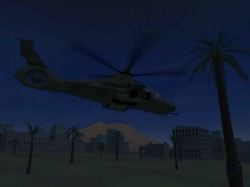
Q. Will infantry present a real danger to my chopper?
A: Some infantry carry shoulder-launched SAMs that definitely pose a threat to your chopper.
Q. Tell us about changes to the interface.
A: The user interface is yet another part of Comanche-Hokum that has been re- written rather than changed. This was necessary to give us features such as allowing the interface to be drawn at any resolution, and the ability to draw animated 3D objects in the front end. Apart from the technical side of things, the user interface has also been re-designed to make it a lot more intuitive and easy to navigate around.
Q. How is intelligence presented to the player between missions?
A: Apache-Havoc was severely lacking in this department - there was such a lot going on in the campaign but the user rarely got to know anything about it.
Comanche-Hokum is the complete opposite in this respect - basically you have access to everything that is happening in the game. You can easily bring up details on every single mission, airbase, farp, factory, tank, jet, helicopter etc. Briefings and debriefings are a lot more detailed than in A-H, and are not just restricted to the player's missions either.
There is also a constantly updating event log which keeps you informed of all manner of events and where they happen, such as units under attack, missions completed/failed, farps captured/lost, etc. You aren't just limited to accessing intelligence between missions either, because of the nature of the fully dynamic campaign all information is equally accessible both between and during missions.

Q. Tell us about debriefs, mission stats. Will we have enduring pilot records?
A: Mission debriefings are still being implemented, but currently contain the following information: Success rate (complete success, partial success or failure). A list of targets destroyed by each member of your group. A list of any wingmen casualties and how they were killed. Plus we can also overlay the actual route the player flew on the map.
Yes, there will be an enduring player log - storing information such as number of missions flown, flying hours, kills, losses, campaigns won etc. Plus there is a full complement of medals to be collected for each side: - Medals may be awarded upon completion of a mission and range from the Purple Heart to the Medal of Honour. Wings are awarded for flying hours clocked up, and there are special medals awarded for successful completion of each campaign.
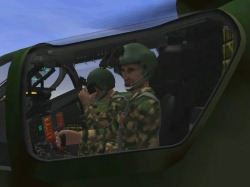
Q. From the look of the cockpits avionics have become more detailed. What kinds of changes will we see here and what difference does it make for the user who wants a higher degree of realism?
A: The avionics are similar to A-H but there are several new MFD pages. Avionics have been added to improve the gameplay rather than increase the micro-detail. For instance, a 'Mission' MFD page has been included so that if you 'hop' from one gunship to another in-flight then you just need to look down to see what it is you're supposed to be doing. This saves returning to the planning screen.
An advantage of the Comanche over the Hokum is that the Comanche has 4 displays in each cockpit so that 8 of the total 10 MFD pages are always visible (if you switch cockpits).
Q. One of the biggest improvements in Apache-Havoc post patch was the flight modelling. Even retreating blade stall was modelled, pushing the model beyond anything seen before in a PC simulation. Will C-H improve on the fm even further, perhaps adding translational lift?
A: Apache-Havoc's flight models were fairly comprehensive but there will be a few improvements for Comanche-Hokum. One of the most noticeable features will be the ability to taxi around airfields. The Pilot will now be able to manoeuvre the aircraft whilst landed and perform rolling takeoffs. Auto-Rotation is also a feature that will be making an appearance. Incidentally, translational lift was modelled in Apache-Havoc.
Q. What kind of research is necessary to accurately model these platforms? Is information difficult to come by?
A: Comanche Hokum simulates all the forces acting on the aircraft and resolves them to produce realistic behaviours. Every force is modelled, from the wind resistance on the fuselage down to the reduced lift generated by a retreating blade. When all the forces have been modelled correctly it becomes a matter of tuning the flight characteristics. This is where research material comes in, and good beta testers !

Q. Who actually tests the flight models as they near completion?
A: We have a really good group of beta-testers some of whom are fully qualified pilots. We rely on their feedback to get the flight dynamics right.
Q. Tell us what new vehicles/platforms we'll see in the missions.
A: We have added some more helicopters and transport aircraft. We are hoping to add some more tanks as well. New helicopters:
- AH-64A Apache
- Ka-50 Hokum
- OH-58D Kiowa Warrior
- MV-22 Osprey
- AH-1T SeaCobra
- AH-1W SuperCobra
- CH-53E Super Stallion
New aircraft:
- C-17 Globemaster III
- IL-76 Candid-B
- C-130J Hercules II
- AN-12B Cub

Q. Damage modelling is critical to many of our readers. Which systems are modelled for damage in C-H?
A: Damage affects avionics components, weapons systems, rotors, undercarriage, stabilisers etc.
Q. Is damage to our chopper modelled graphically for particular areas on the airframe?
A: Damaged rotors are shown but no airframe damage.
Q. What kinds of weapon systems are modelled for the Comanche? For the Havoc? What level of realism are you aiming for here?
A: Comanche:
- 20mm Cannon
- AIM-92 Stinger
- AGM-114L Longbow Hellfire
- AGM-114K Hellfire II
- Hydra 70 M255 FFAR
- Hydra 70 M261 FFAR
Hokum:
- 30mm Cannon (switchable AP/HE rounds)
- Igla-V (IR air-to-air)
- Vihkr (anti-tank guided missiles)
- S8 80mm FFAR
- S130 130mm FFAR
- GSh-23L cannon pods
The level of realism is the same as A-H except we now take account of the penetration angle/weapon effectiveness (for example tanks have more armour at the front).

Q. Are these choppers evenly matched when they go head to head?
A: I'd rather take my chances in the Comanche but the Hokum does have the ejector seats. On the other hand the Comanche is more stealthy but the Hokum is more manoeuvrable ...
Q. Making a simulation accessible to the novice is also important. How does C-H accomplish this? Are there training missions? Will they contain a simulated instructor?
A: We have improved the accessibility to the novice player by having 'Novice' and 'Realistic' avionics modes and we will have a quickstart keyboard guide in the box.
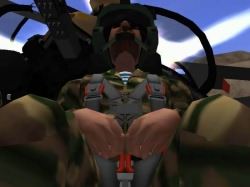
Ejection Sequence: #1
There are no scripted training missions, although 'Free Flight' will still be included and the player can practice flying, targeting and weapon drills in a passive environment.
The AI engine for C-H is fully dynamic and therefore it is very difficult to script training missions because you can't guarantee the same events will happen time after time. We made a decision to put our effort into improving the AI for the dynamic campaign instead.
Q. Tell us about the terrain. Will we see individual trees?
A: The terrain is similar to A-H in that we have the solid forests with a skirting tree line but we will include more individual trees. We have also made the curves in the roads and rivers smoother.
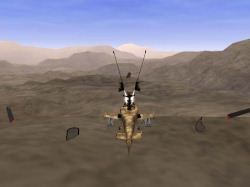
Ejection Sequence: #2
Q. Will you support hardware T&L? How does this impact the frame rate?
A: We do support T&L and it makes a substantial difference to the frame rate.
Q. What will be the recommended system spec to run at high detail at 1024x768? What about medium detail at 800x600?
A: It's impossible to state system specs at this time because the program needs to be finished and optimised. The memory footprint for C-H is smaller than A-H so there will be less memory paging. On my development system (PII 400 + VooDoo3) changing screen resolution doesn't affect the frame rate too much because the program is not fill rate bound.
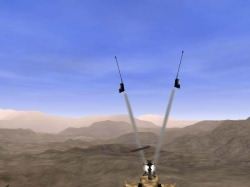
Ejection Sequence: #3
Q. Tell us about connectivity between A-H and C-H?
A: If you have A-H installed on your PC, C-H will detect this and allow you to select the Apache and Havoc gunships in addition to the Comanche and Hokum gunships.

Ejection Sequence: #4
Q. What is the goal for multiplayer features?
A: The goal is to make a C-H campaign playable across the Internet. With A-H the LAN game worked fine but the Internet game was troubled with the reliability of packet delivery and latency. Oh.. and there will be tandem cockpits for two players to co-op in the same machine.
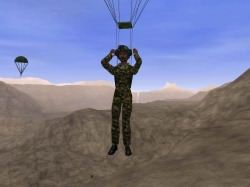
Ejection Sequence: #5
Q. Any chance we'll see a spiral bound manual this time?
A: Not sure yet. Manufacturing decisions are made by our publisher.
Q. When can we expect to see this one on the shelves?
A: C-H will be completed by the end of March 2000 and should be available soon after that. Thanks!!